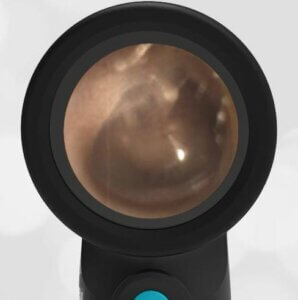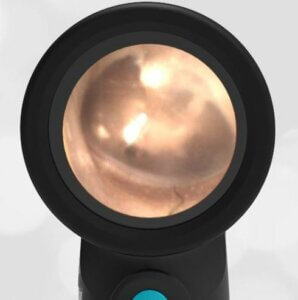
Worried Parents
Parents of a 16-month-old present to the University of Wisconsin – Madison academic Emergency Department with their child for a second opinion. They report that their son has been pulling at his ears frequently over the past month and occasionally seems uncomfortable. They have not recorded a fever and he has not been congested or otherwise ill. They took him to the local ED three weeks ago where he was diagnosed with an ear infection and prescribed an antibiotic for 10 days. The patient completed the antibiotics but they did not notice any improvement—he was still occasionally irritable and sticking his fingers in his ears—so they had him follow-up with his primary physician who described “fluid behind his ears.” Unsatisfied, the parents then decided to drive 60 miles to our Pediatric Emergency Department for another assessment.
The following images were obtained with the Wispr:
- Left TM
- Right TM
What is your diagnosis and action plan?
The child’s Wispr exam revealed very normal-appearing tympanic membranes without evidence of bulging or middle ear effusion (MEE). In fact, recalling that it can take 4-6 weeks for full resolution of MEE and normalization of the TM appearance, the findings made us question (internally) the recent diagnosis of an otitis media requiring antibiotics. Regardless of whether or not he indeed had rapid resolution of an AOM, the child does not have evidence of MEE as reported earlier today.
What to do about a fussy 16month-old who is constantly “pulling at his ears”? Toddlers obviously pull at their ears for any number of reasons that are unrelated to AOM or MEE. From the impressive-sounding Eustachian tube dysfunction to the simple fact that little kids sometimes pull at their ears just because they are there, providers must caution that they do not default to AOM nor dismiss parental concerns by reporting questionable physical findings. As can be learned from this case, such an approach may result in unnecessary anxiety, inconvenience, and medical costs–by a reasonable estimate, the total healthcare expenses of this episode easily surpassed $1000.
One of the most obvious benefits of utilizing digital otoscopy is ensuring an accurate diagnosis. However, a close second is the ability to share the objective findings with your patients and parents. As we reviewed their child’s Wispr exam, I took the exact same approach that I use when teaching; pointing out landmarks, lack of bulging, redness, or fluid. During this review, I also pointed out a finding that all of you have surely already identified—there is a small dark brown hair up against the child’s left TM. The parents note that they have a black lab (awesome dogs, but notorious for shedding). While the family pet is likely the source of the little hair, whether this is actually the reason for the child to pull at his ears is unclear. It seems rational, but I would not discount the fact that the child just likes to pull on his ears. Regardless, the parents left the ED feeling very relieved, satisfied, and confident that nothing worrisome was being missed.
Here are videos of the exam from each ear:
|
Left TM |
Right TM |









































































































































































































